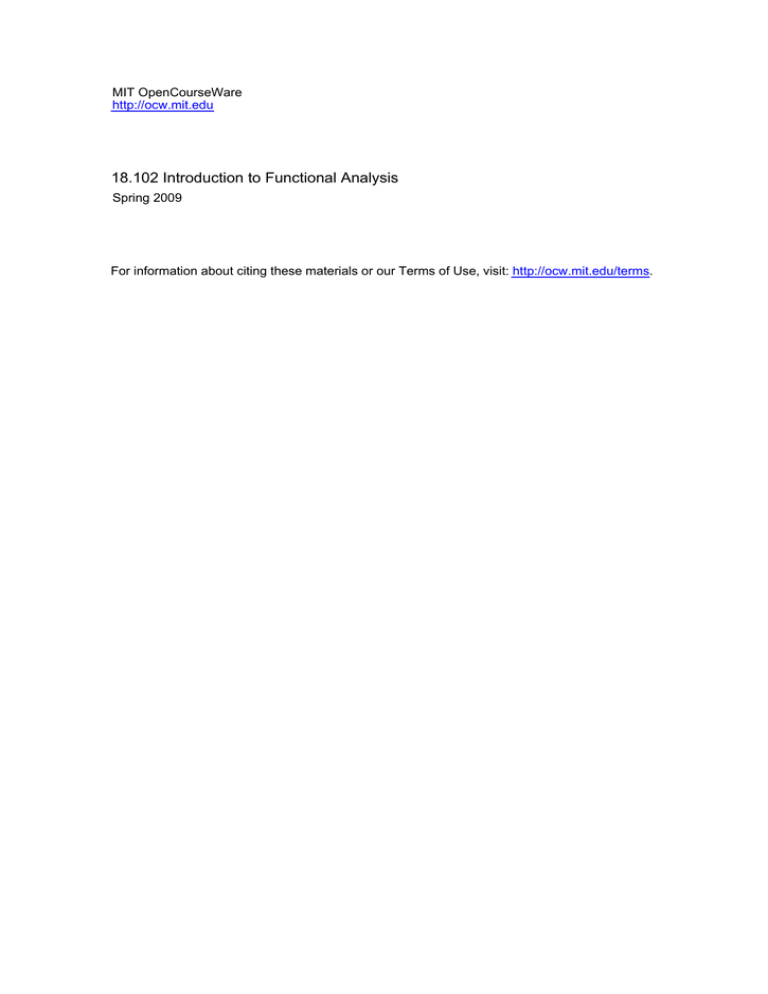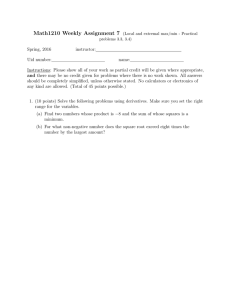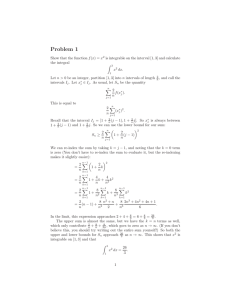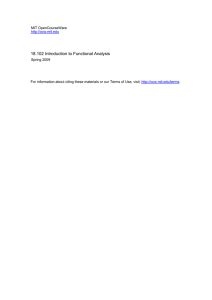18.102 Introduction to Functional Analysis
advertisement

MIT OpenCourseWare http://ocw.mit.edu 18.102 Introduction to Functional Analysis Spring 2009 For information about citing these materials or our Terms of Use, visit: http://ocw.mit.edu/terms. PROBLEM SET 2 FOR 18.102, SPRING 2009 DUE 11AM TUESDAY 24 FEB. RICHARD MELROSE I was originally going to make this problem set longer, since there is a missing Tuesday. However, I would prefer you to concentrate on getting all four of these questions really right! 1. Problem 2.1 Finish the proof of the completeness of the space B constructed in lecture on February 10. The description of that construction can be found in the notes to Lecture 3 as well as an indication of one way to proceed. 2. Problem 2.2 Let’s consider an example of an absolutely summable sequence of step functions. For the interval [0, 1) (remember there is a strong preference for left-closed but right-open intervals for the moment) consider a variant of the construction of the standard Cantor subset based on 3 proceeding in steps. Thus, remove the ‘central interval [1/3, 2/3). This leave C1 = [0, 1/3) ∪ [2/3, 1). Then remove the central interval from each of the remaining two intervals to get C2 = [0, 1/9) ∪ [2/9, 1/3) ∪ [2/3, 7/9) ∪ [8/9, 1). Carry on in this way to define successive sets Ck ⊂ Ck−1 , each consisting of a finite union of semi-open intervals. Now, consider the series of step functions fk where fk (x) = 1 on Ck and 0 otherwise. (1) Check that this is an absolutely summable series. � (2) For which x ∈ [0, 1) does |fk (x)| converge? k (3) Describe a function on [0, 1) which is shown to be Lebesgue integrable (as defined in Lecture 4) by the existence of this series and compute its Lebesgue integral. (4) Is this function Riemann integrable (this is easy, not hard, if you check the definition of Riemann integrability)? (5) Finally consider the function g which is equal to one on the union of all the intervals which are removed in the construction and zero elsewhere. Show that g is Lebesgue integrable and compute its integral. 3. Problem 2.3 2 The covering lemma for R . By a rectangle we will mean a set of the form [a1 , b1 ) × [a2 , b2 ) in R2 . The area of a rectangle is (b1 − a1 ) × (b2 − a2 ). (1) We may subdivide a rectangle by subdividing either of the intervals – re­ placing [a1 , b1 ) by [a1 , c1 ) ∪ [c1 , b1 ). Show that the sum of the areas of rectangles made by any repeated subdivision is always the same as that of the original. 1 2 RICHARD MELROSE (2) Suppose that a finite collection of disjoint rectangles has union a rectangle (always in this same half-open sense). Show, and I really mean prove, that the sum of the areas is the area of the whole rectange. Hint:- proceed by subdivision. (3) Now show that for any countable collection of disjoint rectangles contained in a given rectange the sum of the areas is less than or equal to that of the containing rectangle. (4) Show that if a finite collection of rectangles has union containing a given rectange then the sum of the areas of the rectangles is at least as large of that of the rectangle contained in the union. (5) Prove the extension of the preceeding result to a countable collection of rectangles with union containing a given rectangle. 4. Problem 2.4 (1) Show that any continuous function on [0, 1] is the uniform limit on [0, 1) of a sequence of step functions. Hint:- Reduce to the real case, divide the interval into 2n equal pieces and define the step functions to take infimim of the continuous function on the corresponding interval. Then use uniform convergence. (2) By using the ‘telescoping trick’ show that any continuous function on [0, 1) can be written as the sum � (1) fj (x) ∀ x ∈ [0, 1) i where the fj are step functions and � |fj (x)| < ∞ for all x ∈ [0, 1). j (3) Conclude that any continuous function on [0, 1], extended to be 0 outside this interval, is a Lebesgue integrable function on R. Department of Mathematics, Massachusetts Institute of Technology





